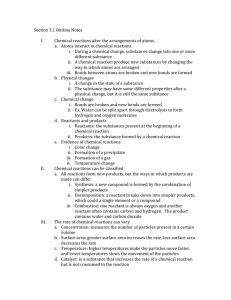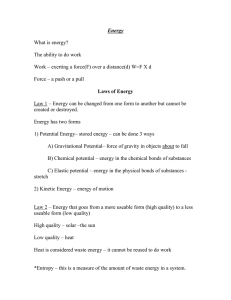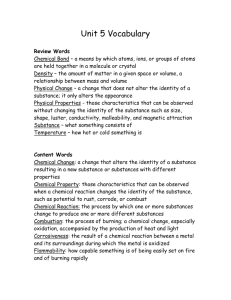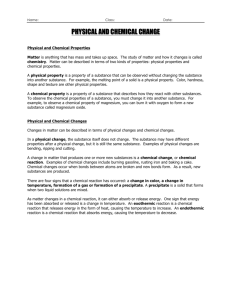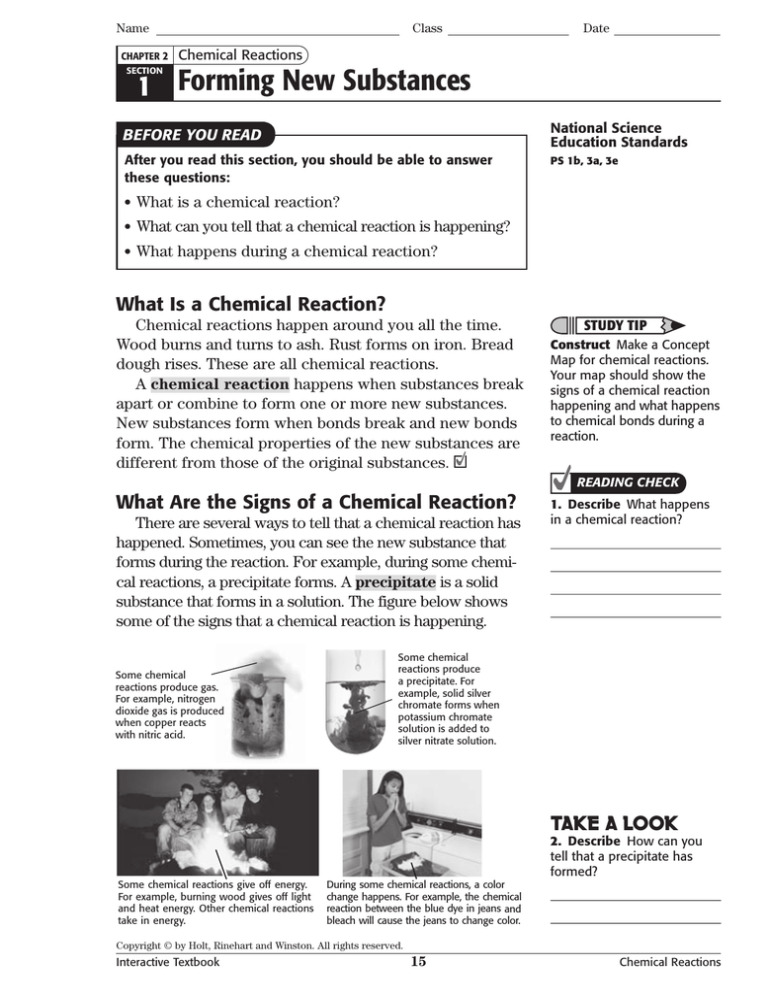
Name
CHAPTER 2
Class
Date
Chemical Reactions
1 Forming New Substances
SECTION
National Science
Education Standards
BEFORE YOU READ
After you read this section, you should be able to answer
these questions:
PS 1b, 3a, 3e
• What is a chemical reaction?
• What can you tell that a chemical reaction is happening?
• What happens during a chemical reaction?
What Is a Chemical Reaction?
Chemical reactions happen around you all the time.
Wood burns and turns to ash. Rust forms on iron. Bread
dough rises. These are all chemical reactions.
A chemical reaction happens when substances break
apart or combine to form one or more new substances.
New substances form when bonds break and new bonds
form. The chemical properties of the new substances are
different from those of the original substances.
What Are the Signs of a Chemical Reaction?
There are several ways to tell that a chemical reaction has
happened. Sometimes, you can see the new substance that
forms during the reaction. For example, during some chemical reactions, a precipitate forms. A precipitate is a solid
substance that forms in a solution. The figure below shows
some of the signs that a chemical reaction is happening.
Some chemical
reactions produce gas.
For example, nitrogen
dioxide gas is produced
when copper reacts
with nitric acid.
STUDY TIP
Construct Make a Concept
Map for chemical reactions.
Your map should show the
signs of a chemical reaction
happening and what happens
to chemical bonds during a
reaction.
READING CHECK
1. Describe What happens
in a chemical reaction?
Some chemical
reactions produce
a precipitate. For
example, solid silver
chromate forms when
potassium chromate
solution is added to
silver nitrate solution.
TAKE A LOOK
Some chemical reactions give off energy.
For example, burning wood gives off light
and heat energy. Other chemical reactions
take in energy.
During some chemical reactions, a color
change happens. For example, the chemical
reaction between the blue dye in jeans and
bleach will cause the jeans to change color.
2. Describe How can you
tell that a precipitate has
formed?
Copyright © by Holt, Rinehart and Winston. All rights reserved.
Interactive Textbook
15
Chemical Reactions
Name
SECTION 1
Class
Date
Forming New Substances continued
CHANGING CHEMICAL PROPERTIES
READING CHECK
3. Explain Does seeing a
gas produced always mean a
chemical reaction is occurring?
Explain.
Seeing signs of a chemical reaction does not always
mean that a reaction is happening. For example, a gas
(water vapor) is given off when water boils. Recall that
boiling is a physical change, not a chemical reaction. You
can tell that it is a physical change because water vapor
can condense to form liquid water. In a chemical change,
a new substance must be produced.
How can you be sure that a chemical reaction is
happening? The best way is to look at the chemical
properties of the substance that forms. The new
substances that form during chemical reactions always
have different chemical properties than the original
substances. The figure below shows an example of how
chemical properties change during a chemical reaction.
This sulfuric acid is a clear liquid.
STANDARDS CHECK
PS 1b Substances react chemically in characteristic ways with
other substances to form new
substances (compounds) with
different characteristic properties. In chemical reactions,
the total mass is conserved.
Substances often are placed in
categories or groups if they react
in similar ways; metals is an
example of such a group.
Word Help: chemical
of or having to do with the
properties or actions of
substances
4. Explain What happens
to the chemical properties of
substances during a chemical
reaction?
This sugar is a white solid.
When sulfuric acid reacts with sugar,
new substances with different
properties form. Carbon is a black
solid. Water vapor is a colorless gas.
The starting materials in this reaction are sugar and
sulfuric acid. There are signs that a chemical reaction
occurs. Bubbles form, a gas is given off, and the beaker
gets very hot.
The most important sign that a chemical reaction occurs
is the formation of new substances. The new substances are
carbon, a brittle black solid, and water vapor, a colorless
gas. The properties of these new substances are not at all
like the properties of sugar and sulfuric acid.
Copyright © by Holt, Rinehart and Winston. All rights reserved.
Interactive Textbook
16
Chemical Reactions
Name
SECTION 1
Class
Date
Forming New Substances continued
How Do New Substances Form?
Chemical reactions happen when chemical bonds
are broken and formed. A chemical bond is a force that
holds two atoms together in a molecule. During a chemical reaction, some of the bonds in the original molecule
break. New bonds form to produce a new substance.
Remember that molecules are always moving. If the
molecules in a substance bump into each other with
enough energy, some of the bonds in the molecules can
break. The atoms can form new bonds with different
atoms. A new substance forms. The figure below shows
an example of how new substances can form.
Hydrogen and chlorine are
diatomic molecules. Diatomic
molecules are made of two
atoms bonded together. In
order for hydrogen to react with
chlorine, the bonds between the
atoms must break.
Hydrogen
Chlorine
READING CHECK
5. Describe What happens
to chemical bonds during a
chemical reaction?
TAKE A LOOK
New bonds can form between
hydrogen atoms and chlorine
atoms. A new substance,
hydrogen chloride, forms.
Hydrogen chloride is also a
diatomic molecule.
6. Identify Hydrogen and
chlorine react to produce
hydrogen chloride. What bonds
are broken and what bonds are
formed during this reaction?
Hydrogen chloride
In this example, both elements exist as diatomic molecules. Chlorine is a greenish-yellow gas and hydrogen
is a colorless gas that is flammable. When they react, the
bond between the hydrogen atoms breaks and the bond
between the chlorine atoms breaks.
New bonds form between hydrogen and chlorine
atoms. The product of the reaction is hydrogen chloride.
Hydrogen chloride is a nonflammable, colorless gas. Its
properties are very different from those of hydrogen or
chlorine.
Let’s look at another example. Sodium is a metal that
reacts violently with water. When sodium and chlorine
react, they make a new substance, sodium chloride. You
use sodium chloride as table salt. Sodium and chlorine
are both toxic substances, but sodium chloride is not.
Copyright © by Holt, Rinehart and Winston. All rights reserved.
Interactive Textbook
17
Chemical Reactions
Name
Class
Section 1 Review
Date
NSES
PS 1b, 3a, 3e
SECTION VOCABULARY
chemical reaction the process by which one or
more substances change to produce one or
more different substances
precipitate a solid that is produced as a result of
a chemical reaction in solution
1. Identify Why is the formation of a precipitate a possible indication of a
chemical reaction?
2. Identify Complete the table to identify the four possible signs of a chemical change.
Observed during a chemical reaction Sign of a chemical reaction
a precipitate forms in a solution
heat given off
green gas observed
colorless solution turned blue
3. Identify What is the force that holds two atoms together in a molecule?
4. Apply Concepts Explain why water boiling is not a chemical reaction, even though
it releases a gas.
5. Infer A scientist mixes substance A and substance B in a beaker. Neither
substance A nor substance B can conduct electricity. The material in the beaker
changes color, and the beaker becomes very hot. The material left in the beaker
conducts electricity. Has a chemical reaction occurred? Explain your answer.
Copyright © by Holt, Rinehart and Winston. All rights reserved.
Interactive Textbook
18
Chemical Reactions
L
Interactions of Matter Answer Key continued
SECTION 2 CHEMICAL FORMULAS AND
EQUATIONS
4. The properties of oxygen change; water
does not have the same properties as
oxygen.
5. Metals can conduct electricity, can be
stretched into wires, and can be hammered
into thin sheets.
1. the elements found in a substance and
2.
3.
4.
5.
Chapter 2 Chemical
Reactions
SECTION 1 FORMING NEW SUBSTANCES
6.
1. One or more substances break apart or com-
bine to form one or more new substances.
7.
2. A solid forms in a solution.
3. No, some physical changes, like boiling, may
produce a gas.
4. The chemical properties of the new substances are different from those of the
original substances.
5. Some bonds are broken and new bonds
form.
6. The bonds in the hydrogen and chlorine
molecules are broken. The bonds in the
hydrogen chloride molecule form.
8.
9.
10.
11.
Review
1. A chemical formula represents a substance.
Review
1. New substances are formed during a chemi-
A chemical equation represents a chemical
reaction.
cal reaction. Formation of a precipitate is
one sign that a new substance has been
formed.
2.
Observed during a
chemical reaction
Sign of a chemical
reaction
precipitate in a solution
solid formation
heat given off
energy change
green gas
gas formation
colorless solution turned
blue
color change
how many atoms of each element are in a
molecule
three
PCl3
3+
a short way to show what happens in
a chemical reaction using symbols and
formulas
Reactants: C, O2
Products: CO2
If you use the wrong chemical formula, a
chemical equation will not describe the
reaction you are trying to describe.
A chemical equation shows that no
atoms are lost or gained during a chemical
reaction.
a number that is placed in front of a
chemical formula
subscripts
2Na Cl2
2NaCl
2.
3. chemical bond
4. When water boils, a new substance is not
Chemical
equation
Number
of atoms
in the
reactants
Number
of atoms
in the
products
Is the
equation
balanced?
Na Cl2
NaCl
Na 1
Cl 2
Na 1
Cl 1
no
HCl
NaOH
NaCl H2O
H2
Cl 1
Na 1
O1
H2
Cl 1
Na 1
O1
yes
2Sb 3I2
2SbI3
Sb 2
I6
Sb 2
I6
yes
3. SiO2: silicon dioxide
formed. The water vapor that forms during
boiling can condense into liquid water.
5. The chemical properties of the material in
the beaker are different from those of the
original substances. This shows that a chemical reaction must have occurred.
SbF3: antimony trifluoride
4. Changing the subscripts changes the substance in the chemical reaction. Therefore,
if you change subscripts, you change the
chemical reaction that you are describing.
5. 3Mg N2
Mg3N2
Copyright © by Holt, Rinehart and Winston. All rights reserved.
Interactive Textbook Answer Key
76
Interactions of Matter



